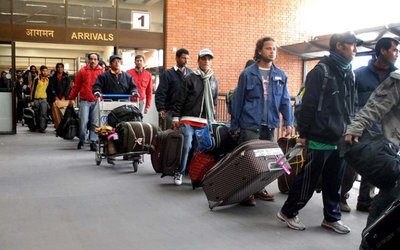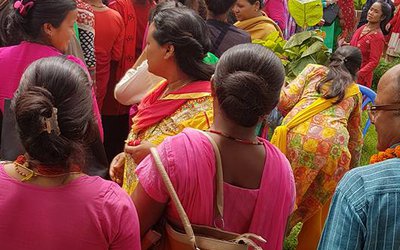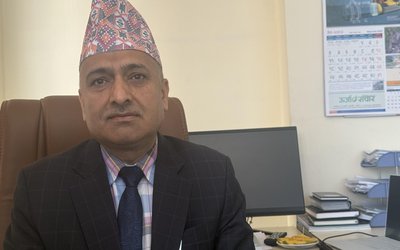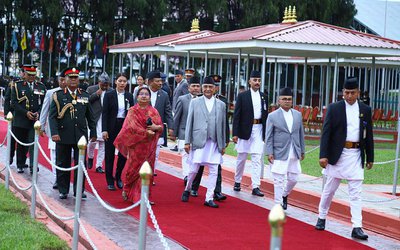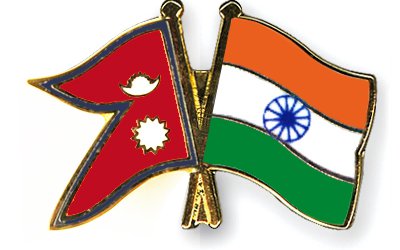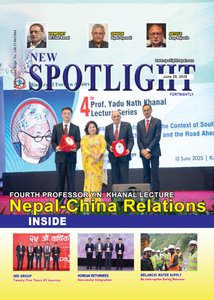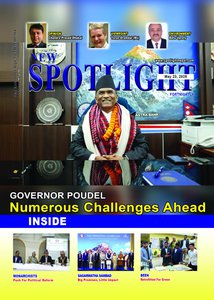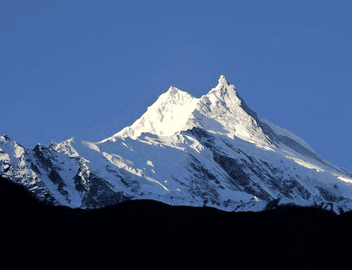
Introduction
In a recent issue of New Spotlight (January 10, 2025), Juddha Bahadur Gurung, who it appears is a member of the International Eco-Tourism Society, Eurasian Chapter (Turkey), wrote about what he referred to variously as ‘Arabian visitors’ and ‘the Muslim community’, which he suggests ‘is collectively known as ‘the Arab League’ in a piece on tourism in Nepal. His piece contains misleading information and requires correction; but he raises what is in fact an interesting question – why are there so few tourists coming to Nepal from the Arab or Muslim countries, and what is to be done about this?
Firstly, we need to be clear that there is an important distinction between the predominantly ‘Arab countries’ of North Africa and the Middle East, including the Gulf states, on the one hand, and ‘Muslim countries’, on the other. Mr Gurung uses these virtually interchangeably. The first group – the Arab countries - includes: Mauritania, Morocco, Algeria, Tunisia and Libya (in the Maghreb), and Egypt, Jordan, Palestine, Lebanon, Syria and Iraq (the Mashraq), as well as the Gulf States of Yemen, Saudi Arabia, Kuwait, Qatar, Bahrain, Oman and the United Arab Emirates (UAE), including Abu Dhabi, Dubai, Sharjah, Ajman, Umm al Quwain, Ras al Khaimah and Fujaira.
The Arab countries are all predominantly Muslim, although there are significant indigenous Christian minorities in both Lebanon and Syria. But there are many Muslim countries (where the majority of the population are Muslims) that are not Arab countries. Leaving aside those sub-Saharan African countries where there is a significant minority Muslim population, and Albania and Bosnia-Herzegovina in Europe, these include Turkey and Iran (in the Middle East), Pakistan, Bangladesh and the Maldives (in South Asia), Afghanistan, Tajikistan, Turkmenistan, Uzbekistan, Kazakhstan, Kyrgyzstan (all in Central Asia) and Brunei Darussalam, Indonesia, Malaysia and Myanmar (in South East Asia).
The Arab League, to which Mr Gurung refers, is a largely political association of countries, including Mauritania, Morocco, Algeria, Tunisia, Libya, Egypt, Lebanon, Palestine, Syria, Jordan, Iraq, Saudi Arabia, the UAE, Kuwait, Yemen, Bahrain, Oman, Qatar, and also Sudan, Somalia, Djibouti and the Union of the Comoros. Gurung refers to the ‘combined wealth’ of the countries of the Arab League. The League as such, however, has little relevance for a discussion of the tourism industry.
Tourism and Nepal
Nepal, with its geographical location in the Himlayas between India and China (Tibet), is blessed with a diverse ecology, giving rise to rich bio-diversity and a range of specialist tourist activities, including ‘out-door’ adventure holidays (trekking, camping, white water rafting, hang-gliding, mountaineering, etc.) as well as wildlife safaris and bird-watching expeditions (mainly in the terai), visits to place of heritage, religious visits and pilgrimages. From the 1970s onwards, it has identified itself as a significant tourist destination.
Having risen on and off, year on year, for decades, the number of tourists visiting Nepal dropped like a stone in 2020, when the covid epidemic suddenly prevented travel across the world. The advertising campaign ‘Visit Nepal 2020’, already poorly received and poorly marketed in Europe and North America, proved a failure. In 2021, Nepal received the lowest number of tourists for many year,150,962. By 2022, however the numbers were already climbing again, with a total of 614,869 visitors; and in 2023, the number of tourists reached a total of over 1 million, marking a significant recovery.
The next year, 2024, saw a total of just over 79,000 coming to visit in January alone; by the end of February, the number had risen to around 176,500. It seemed that tourism to Nepal was once again rising, promising bumper months ahead. By the end of the year, a total of well over 1 million visitors had come to Nepal (1,147,567), a 13 % increase on 2023 and up to 96% of pre-pandemic levels. The largest number of visitors came from mother countries in South Asia, notably from India; but the biggest increase in percentage terms was from China and East Asia, with Chinese arrivals increasing by 67%. Europe and North America remained strong source markets, while Australia and New Zealand showed a robust recovery.
According to the annual World Travel and Tourism Council’s research report, Nepal’s tourism sector generated Rs 327.9 billion ($2.5 billion) in revenue and supported 1.19 million jobs directly and indirectly in 2023. For comparison, the stock of Foreign Direct Investment (FDI) in Nepal amounted to Rs 264.3 billion at the end of 2021/22, with India and China the top two investors.
Tourism and the Arab Gulf countries.
Mr Gurung asks why are there so few tourists coming to Nepal from the Arab or Muslim countries, and what is to be done about this? The total population of the Arab World is around 473 million people; and there are over 1.8 billion Muslims in the world. Even if we consider only the combined population of the Gulf States, it amounts to about 23 million, of which the large majority are Saudis (18.8 million). This is a sizeable number of people, and a region with with well above average wealth.
The eight Gulf States all have relatively high per capita GDP in current prices, with the top five having the highest figures: Qatar ($119 thousand), UAE ($82 thousand), Bahrain ($67 thousand), Saudi Arabia ($66 thousand) and Kuwait ($51 thousand).. The total outbound travel market from the Gulf States was worth about $76 billion in 2023, with Saudi Arabia contributing the largest share at nearly half of total expenditure. The total market is expected to be around $82 billion in 2025, probably climbing to some $140 billion by 2032.
Those who do travel abroad as tourists, however, go mainly to Europe and to North America, also to other countries in the Middle East and to Southeast Asia, where they usually prefer luxury resorts and experiences. Saudi Arabia alone sends over a million tourists to Thailand. According to one source (Glasgow Research and Consulting, see Consultancy-me.com), and, significantly, expenditure on outward bound tourism by people from these few rich countries has enjoyed a combined average growth rate of 20 per cent over the past six years, with a strong preference for luxury and exclusive experiences.
Travelling for the most part in family groups, tourists from the Gulf seem to prefer well-packaged visits, which allow for the observation of food preferences and prohibitions, as well as the segregation of the women in the group and other cultural facilities reproducing familiar practices from the home country. Carefully curated visits to local heritage sites, cultural and sporting events, wild-life safaris, luxury shopping, entertainment and casinos appear to be the main kind of attraction for visitors from the Gulf. It seems that male travellers prefer casinos, while females prefer shopping; these can be found easily in more developed Asian tourist destinations, like Thailand and Malaysia. Every year, more than a million tourists from the Gulf States arrive there.
But the total number of visitors to Nepal from the six major Gulf States was a mere 3,814 in 2019, before the pandemic, and only 3,311 in 2022. This is despite the excellent connections by air between Nepal and the Gulf, with numerous flights and airlines – including Qatar Airways, Emirates and Fly Dubai, Air Arabia, Kuwait Airways, Jazeera Airlines, Air Arabia Abu Dhabi and Etihad Airways, as well Turkish Airlines, Nepal Airlines and Himalaya Airlines - bringing other tourists direct to Nepal or enabling them to transit in Dubai, Abu Dhabi, Doha, Kuwait, Istanbul, etc.
Religion and Tourism in Nepal
One of the factors considered by Mr Gurung is the attraction of shared cultural values, religious pilgrimage and the possibility of visiting important holy places as important factors in determining the number of tourists coming to Nepal, where the majority of the population are themselves Hindus or Buddhists and where there are important religious for tourists to visit.
Indians constitute by far the largest group of visitors to Nepal – with some 317,773 arriving by air in 2024 and many more by road. Some come for business, but many come for pleasure or for pilgrimage to holy sites. In January 2025, out of 80,000 foreign tourists, more than 20,000 were Indians. Most Indians are Hindus, as are most Nepalis, and the Pashupatinath Temple in Kathmandu, identified as a UNESCO World Heritage Site and the world’s largest temple of Lord Shiva, attracts many pilgrims and tourists. There are also very many other sites of religious significance to Hindus throughout the Kathmandu Valley and elsewhere in Nepal.
The second largest group of visitors to Nepal are now from China and East Asia, where the majority religion is Buddhism. After China, the largest number of visitors from South East Asia come from Thailand, Myanmar and Japan. The second largest religious group in Nepal are Buddhists, and the sacred site of the birth of Lord Gautama Buddha at Lumbini in the southern plains (the terai) - another UNESCO World Heritage Site – is a major attraction; other important Buddhist sites in the Kathmandu Valley and elsewhere in the country are also visited. Mount Kailash in Tibet is a sacred mountain for Hindus and Buddhists, as well as for Jains and the followers of the Bon religion. It is now possible to reach Mount Kailash from Kathmandu by road or from Nepalgunj in western Nepal by helicopter.
Mr Gurung remarks that ‘there is a very small Muslim community in Nepal and almost no Muslim pilgrimage tourist destinations, with very few visitors compared to other regions of the world’ (p.33), suggesting that these are relevant factors when considering the small number of visitors from the Gulf But, in fact, Muslims constitute the third most numerous religious group in Nepal, with around 1.5 million observers of Islam. They account for around 5 per cent of the total population of Nepal, and more than 10 per cent of the population of the southern plains (the terai).
It is true that there are no major religious sites of the importance of Pashupathinath or Lumbini, but there are an estimated 4,000 mosques in Nepal, most of them in the urban areas, including Kathmandu, Pokhara and Biratnagar. In Kathmandu alone, there are four major mosques - the Kashmiri Jama Masjid (also known as the Pancha Kashmiri Takiya Masjid and the oldest mosque in Nepal), the Nepali Jame Masjid, the Masjid Ahle and the Abubakar Siddiq Mosque – as well as numerous smaller local mosques which together serve the 22,000 or so Muslims who live in the Valley. Muslims in Kathmandu celebrate the Aid el Kebir at the end of Ramadan with verve and enthusiasm.
One specific quarter (tol) in Thamel - a noted attraction in its own right to tourists from all kinds of background - is Muslim Tol, where there are local mosques, Islamic centres, halal restaurants and a vibrant Muslim community. Recently, a new restaurant Mazaaj has opened there, offering a traditional Mediterranean menu with a Middle Eastern ambiance. Indra Chowk Pote bazaar is also a centre for Muslims in the city, where pote (tiny colourful plastic or glass beads) are sold by predominantly Muslim vendors to local Hindu women. There are also many localities in Kathmandu, especially in Thamel, where foreigners from anywhere can buy distinctively Nepali curios, statues and ornaments, paintings and Tibetan thankas, and garments (including pashmina shawls).
Outside Kathmandu, Pokhara and Nepalgunj to the West, and Birgunj and Biratnagar to the East offer halal-friendly dining options as well as Islamic centres and mosques (the Masjid-e-Bilala in Pokhara and Shreepur Mosque in Birgunj are prominent examples). There is also the Jama Masjid in Gorkha. There are specific potential places of attraction for Muslim visitors, especially for those from areas formerly under the Moghul Empire, although many of these are outside Kathmandu and in the far west.
As to reasons why Nepal might be less attractive than many other tourist destinations for Muslims is that the hospitality infrastructure catering specifically to Muslims remains limited outside the four main tourist destinations – Kathmandu, Pokhara, Chitwan and the Solukhumbu region (and Mount Everest), while the food culture of Nepal would be unfamiliar and even unacceptable to many Muslims, for whom food should conform to Islamic dietary laws; for example, meat should be halal (permissable or allowed) or slaughtered in accordance with Islamic law, and neither pork nor alcohol are strictly allowed – although in reality many Muslims are not observant.
But, if the number of tourists from the Arab Gulf States, and indeed the number of Muslims generally arriving in Nepal annually as tourists, remains small, there are certainly possibilities of increasing these numbers by careful marketing. The largest number of Muslims coming to visit Nepal as tourists are from Bangladesh.
The Chinese Are Coming
Since China opened up to the world in 1978, its citizens have been travelling abroad in increasing numbersl but it was not until 2002 that China gave Nepal the approved destination status. Numbers coming to Nepal have gradually increased, and Chinese arrivals in Nepal crossed the 100,000 mark for the first time in 2013, mainly as a result of improved air links between the two countries, but also because of the release of the Chinese movie ‘Up in the Wind’, which was filmed in the tourist spots of Kathmandu, Pokhara and Chitwan. Pokhara received more visitors than Kathmandu, with many Chinese tourist guidebooks listing the lake-side city in the western region of Nepal as ‘one of the top ten places in the world to see before you die’. According to the statistics, around 93 per cent of Chinese tourists to Nepal were first-time visitors.
In 2014, Nepal received 123,805 Chinese visitors, but in 2015, the earthquake and India’s blockade caused arrivals to dip to 64,675, a decline of 48 per cent on the previous year. The surface road at the Tatopani border point, where many Chinese visiitors crossed into Nepal by road, was also blocked. On 25th December 2015, Nepal announced a ‘free visa’ for Chinese tourists, giving them the same treatment as visitors from South Asia. This scheme was implemented from 1sr January 2016. Numbers surged after this and a record number of 153,633 visitors came from China to Nepal in 2018.
In October 2019, President Xi Jinping visited Nepal himself, becoming the first Chinese president to do so since 1996. During his visit, he said that he would encourage Chinese tourists to visit Nepal, stating in an article published in Nepal, that ‘Nepal is the first South Asian country to be designated an approved destination for Chinese tourists’. In 2019, before covid, the number of Chinese visitors totalled 169,543, but the number plummeted in 2020 to 19,257, while in 2021 and 2022 there were only 6,198 and 9,599Chinese in Nepal, mainly diplomats and those stranded in third countries who travelled to Nepal when China enforced strict lock-downs at home.
In March 2023, Beijing finally allowed its citizens to travel once again to Nepal. In March 2024, a year later, 12,000 Chinese visitors came to Nepal, but arrivals dropped to 9,700 in April, 8,000 in May, only 7,000 in June and only 6,000 in both July and August. Problems mentioned included poor air connectivity and lack of Chinese guides and Chine-speaking facilities. However, China also revealed plans, during the visit of Nepali Prime Minister Pushpa Kamal Dahal in September 2024, to promote Nepal as a key tourist destination for Chinese travellers, declaring 2025 as ‘Visit Nepal Year’. It is likely that many will respond and make the trip – even though airfares remain high.
Already, the surge in the number of Chinese tourists before the pandemic interrupted the trend, has had a dramatic effect. Tourism entrepreneurs were quick off the mark as early as 2013, when numbers of Chinese tourists reached six figures. Many tourist attractions, especially in Pokhara, were decorated with Chinese-themed signboards, menus suddenly appeared in Chinese and Chinese cuisine began to compete with Indian and European-North American favourites. In Kathmandu, the area to the south of Thamel, called Jyatha, has, in recent years become, in effect a sort of China-town, and a favourite destination for Chinese tourists. Chinese owned hotels, restaurants, shops and other enterprises have taken over the northern part of this neighbourhood almost entirely, with only the Utse, a long-established Tibetan hotel and restaurant run by an elderly Tibetan couple, defying the trend. There is no doubt that, despite
Current Initiatives
A number of tourist companies, like Himalayan Trekkers, are now beginning to offer tours in Kathmandu specifically aimed at Muslims. Their website states that they ‘offer Muslim travellers an opportunity to experience and learn about many Nepali cultures, including Nepalese Muslim Culture… they will get to visit Jame Mosque and Kashmiri Mosque, and pray there. We will also provide the opportunity to explore two of the UNESCO listed World Heritage Sites, Kathmandu Durbar Square and Swyambunath… We make sure to provide them hygienic halal meals, Muslim-friendly guide and driver’. They were the Travellers’ Choice Winner in 2024 and the reviews they received on Tripadvisor were mainly ‘excellent.
There is a growing trend of tourism to Nepal from Turkey Nepal Tourism Board (NTB) together with several Nepali travel and tour operators, participated in the 29th East Mediterranean International Tourism and Travel Exhibition (EMITT) from 5-7th February 2025. The focus here was, apparently, on adventure tourism, trekking and mountaineering, cultural experiences and eco-tourism. Turkey was a prime ‘target’ for this initiative. There is good connectivity between Istanbul and Kathmandu, but Turkish Airlines is at present the only carrier offering direct flights to Kathmandu from Europe and vice versa from its new Istanbul hub.
One of the problems faced by all airlines taking passengers to Nepal is the relatively high cost of ticketing, handling and landing fees; ticketing and ground handling at Tribhuvan International Airport are twice the amount in Delhi or Bangkok, and landing charges are 30 % higher in Kathmandu than in other South Asian airports. The relevant authorities will need to consider how these high fees can be reduced if flights to Nepal are to be competitive in future. The government has, apparently, formed a task force to look into these matters and also into the two-tier fare structure for foreigners and Nepalis in domestic flights, as a further incentive to bring foreign tourists to Nepal.
It would seem that, in order to attract significantly more visitors from the Arab Gulf and the Middle East more generally, and also to appeal to wealthier and more adventurous tourists from South East and East Asia, Nepal should be concentrating on the high end of the market – four and five star hotels, mountain resorts, health centres and spas, places for meditation and relaxation, and jungle lodges – taking advantage of Nepal’s unique geography and ecologies. Travel agents should be offering international quality service and carefully packaged experiences, taking full advantage of the unique religious and broader cultural heritage, as well as the wildlife and spectacular mountains. Helicopter flights in and across the Himalayas, to destinations such as Solukhumbu and Mount Everest, Pokhara and Fewa Tal, Annapurna, Rara Lake and Mount Kailash, and down to the terai to enjoy safaris in Chitwan and elsewhere, could be a special attraction.
Generally, improved procedures – for greater speed and security – as regards travel to and from, and within, Nepal (eg visa concessions) and VIP personal treatment throughout the stay in-country are also needed to give confidence that, despite Nepal’s Third World status, the visitors’ welcome will be warm and their experience first class.
Dr. Seddon is the author of ‘The Muslim Communities of Nepal’ (Adroit Publishing), 2018.

Dr.David Seddon
Seddon is a development analyst with a long involvement in Nepal. He is co-author, among other works, of Nepal in Crisis: growth and stagnation at the periphery, and has contributed previously to New Spotlight.
- The (Poor) State Of Nepal’s Economy – Re-Visited
- Jan 27, 2019
- The (Poor) State of the Economy – Re-Visited
- Jan 07, 2018
- The (Poor) State Of The Economy
- Aug 12, 2017

